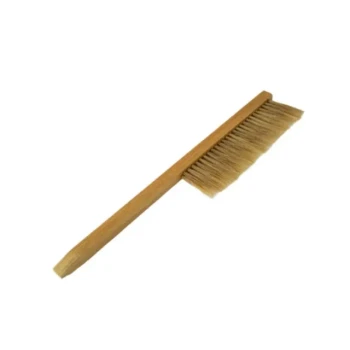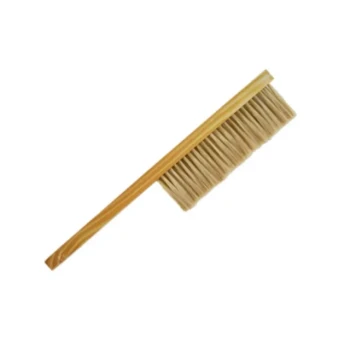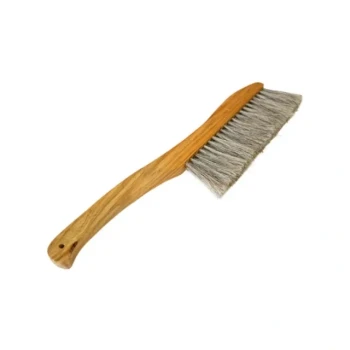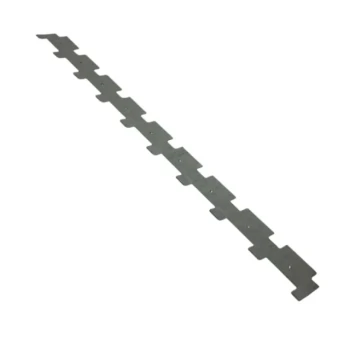In short, a bee brush is used to gently sweep bees off the surfaces of honey frames right before you remove them from the hive. This crucial step ensures that you can transport honey-filled frames for extraction without carrying thousands of attached bees with you. It is a fundamental tool for separating the bees from the honey they've produced.
A bee brush is a simple instrument for a critical task: clearing frames for harvest. However, its effectiveness hinges on the beekeeper's technique, as improper use can agitate the colony and complicate the entire process.
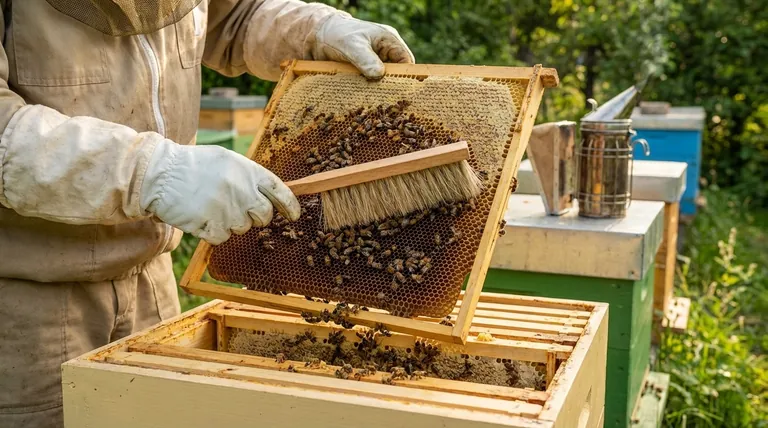
The Role of the Bee Brush in Honey Extraction
A honey harvest is a disruptive event for a colony. Your goal is to be as efficient and calm as possible, and the bee brush, when used correctly, is a key part of that process.
The Basic Workflow
Before you can extract honey, you must get the frames out of the hive and away from the bees. A bee brush is the most direct way to accomplish this.
You pull a single frame of capped honey from a super. Holding it over the hive, you use the brush to gently push the bees off the comb and back down into the colony below.
The Proper Brushing Technique
The correct technique is a gentle but firm sweeping motion. You are not scrubbing the frame; you are ushering the bees off the surface.
Start at the top of the frame and use long, downward strokes. This encourages the bees to move in one direction and drop back into the hive opening. Avoid rapid, jerky movements which bees perceive as a threat.
Why Gentleness is Critical
Bees react defensively to being forcefully handled. Aggressive brushing can crush bees, which releases alarm pheromone. This chemical signal instantly alerts other bees in the colony to a threat, dramatically increasing the odds of stings.
A calm, gentle approach minimizes this stress response, keeping both you and the bees safer.
Understanding the Trade-offs and Alternatives
While a bee brush is an essential tool, it is not the only method for clearing frames, and it's not always the best one. Understanding its limitations is the mark of an experienced beekeeper.
The Primary Downside: Agitation
Bees inherently dislike being brushed. Many will become defensive, fly up in agitation, and even aggressively sting the brush itself. For this reason, a brush should be used deliberately and sparingly. Over-brushing will create a chaotic and unpleasant experience.
When Brushing is Most Effective
The bee brush is ideal for small-scale harvests. If you are only pulling two or three frames from a single hive, the brush is the fastest and most straightforward method. It requires no advance setup.
Common Alternatives to Brushing
For larger harvests or for beekeepers who wish to minimize disturbance, other tools are more suitable.
Bee escapes are one-way doors placed between the honey supers and the brood box a day or two before harvest. Bees can travel down into the main hive but cannot get back up, leaving you with nearly empty honey boxes that can be removed with very little disturbance.
Fume boards are lids fitted with an absorbent cloth. A non-toxic but unpleasant-smelling repellent is applied to the cloth, and the board is placed on top of the hive. The fumes drive the bees downward out of the honey supers, clearing them in minutes. This is a fast method favored by commercial operations.
Making the Right Choice for Your Harvest
Your ideal method for clearing bees depends entirely on the scale of your operation and your primary goal.
- If your primary focus is a quick harvest of only a few frames: A bee brush is the most direct and efficient tool for the job.
- If your primary focus is minimizing all stress on the colony: A bee escape is the gentlest method, though it requires 24-48 hours of advance planning.
- If your primary focus is clearing many hives with maximum speed: A fume board is the standard tool for efficiency, but it requires careful use of chemical repellents.
Ultimately, mastering the bee brush is about understanding that a calm and gentle beekeeper helps create a calm hive.
Summary Table:
| Method | Best For | Key Consideration |
|---|---|---|
| Bee Brush | Small-scale harvests, quick access | Requires gentle technique to avoid agitating bees |
| Bee Escape | Minimizing colony stress | Requires 24-48 hours of advance setup |
| Fume Board | Large-scale, rapid harvests | Involves use of chemical repellents |
Ready to equip yourself for a successful honey harvest?
Whether you're a commercial apiary managing thousands of hives or a distributor supplying beekeepers, having the right tools is paramount. HONESTBEE supplies durable, high-quality beekeeping supplies and equipment—including bee brushes, fume boards, and more—designed for the demands of professional beekeeping.
Let us help you work smarter and safer. Contact our wholesale team today to discuss your equipment needs and streamline your harvesting operations.
Visual Guide
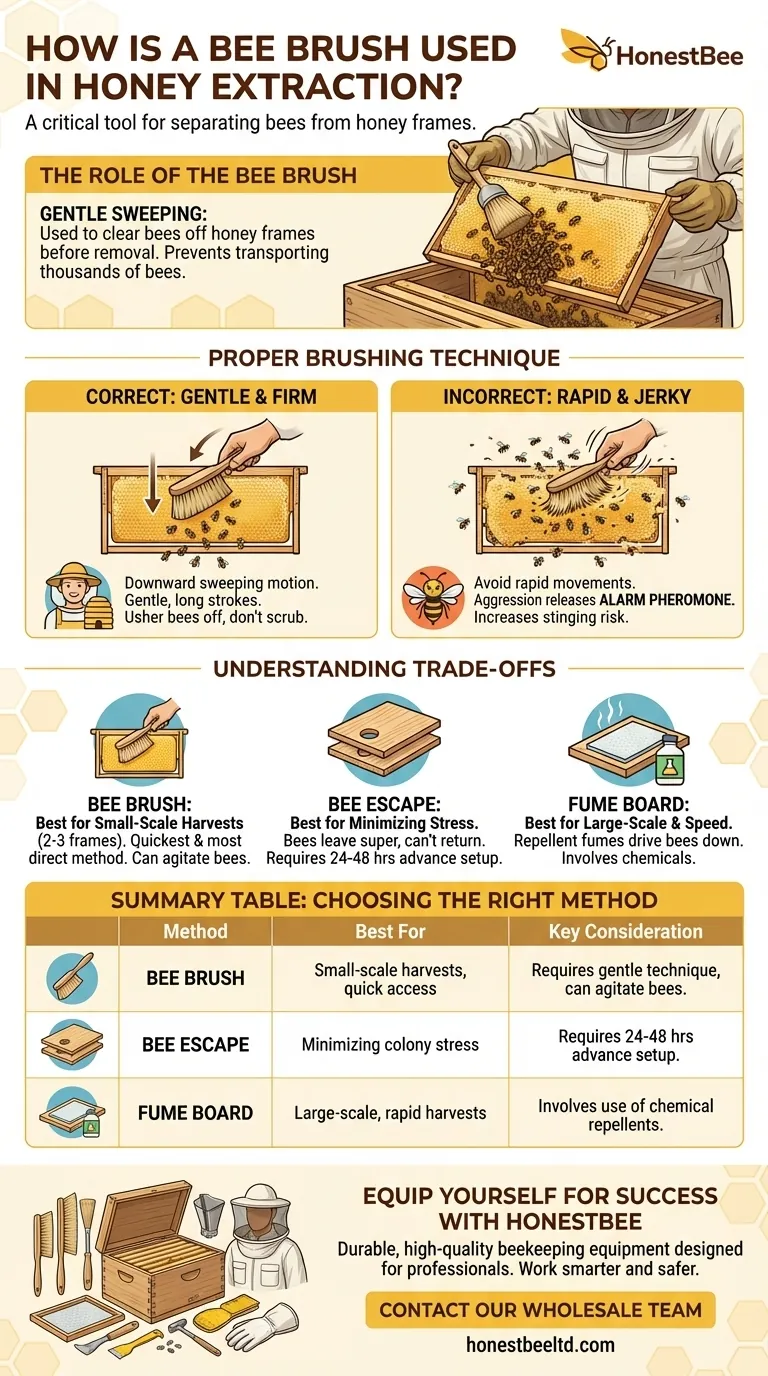
Related Products
- Wooden Bee Brush with Double-Row Horsehair Bristles
- Classic Wooden Bee Brush with Double-Row Boar Bristles
- Plastic Handle Single Row Artificial Fiber Bee Brush
- Double Row Artificial Fiber Bee Brush for Beekeeping
- Wooden Bee Brush with Triple Row Artificial Fiber for Beekeeping
People Also Ask
- What is the primary use of a bee brush during inspections and extraction? Essential for Gentle Bee Handling
- What are some optional tools that can be useful in beekeeping? Boost Efficiency & Hive Health
- What is the function of a bee brush in beekeeping? Master Gentle Bee Handling for Hive Success
- What are the characteristics of a bee brush's bristles and handle? Gentle Tools for Healthy Hives
- What should be done if the swarm is situated on the bottom of a tree limb? A Guide to Methodical Bee Capture

